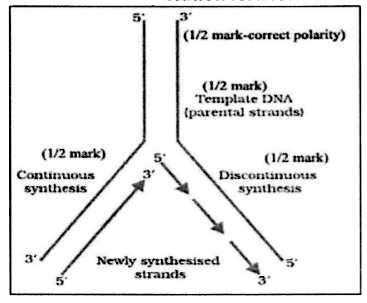Watson and Crick suggested the copying mechanism for DNA wherein the two strands separate and act as template for the synthesis of new complementary strands. With a suitable diagram, show the replication of DNA that occurs within a small opening of DNA helix.
Diagram of replication fork formed during DNA replication

Topper's Solved these Questions
- PRACTICE QUESTION PAPER-2BOOK - CBSE COMPLEMENTARY MATERIALCHAPTER - PRACTICE QUESTION PAPER-2EXERCISE - SECTION C
21 Videos
- PRACTICE QUESTION PAPER - 1 BOOK - CBSE COMPLEMENTARY MATERIALCHAPTER - PRACTICE QUESTION PAPER - 1 EXERCISE - SECTION A
2 Videos
- PRINCIPLES OF INHERITANCE AND VARIATIONBOOK - CBSE COMPLEMENTARY MATERIALCHAPTER - PRINCIPLES OF INHERITANCE AND VARIATIONEXERCISE - QUESTIONS (LA)
3 Videos
Similar Questions
Watson and Crick suggested the copying mechanism for DNA wherein the two strands separate and act as template for the synthesis of new complementary strands. Centrifugal force and the use of isotopes helped to prove the mechanism of replication in E. coli. Explain how it has helped.
View SolutionFor long, DNA molecules, the replication occurs within a small opening of the DNA helix referred to as
View Solution
Knowledge Check
Who suggested that the two strands of DNA separate and each strand acts as a template for the synthesis of new complementary strands?
AWatson and CrickBHershey and ChaseCGriffithDMendetFor long DNA molecules, since the two strands of DNA cannot be separated in its entire length (due to very high energy requirement), the replication occurs within a small opening of the DNA helix, referred to as
AOkazaki fragmentsBSemiconservation replicationCReplication forkDOrigin of replicationDuring replication of DNA , its two strands separate. Each of these serves as a template for the formation of new strands . Such type of replication is called
Anon - conservativeBsemi - conservativeCflexibleDconservative
Method of DNA replication in which two strands of DNA separates and synthesize new strands :-
View SolutionExplain the mechanism of DNA replication as suggested by Watson and Crick.
View SolutionMethod of DNA replication in which two strands of DNA separates and synthesize new strands :-
View SolutionMethod of DNA replication in which two strands of DNA separates and synthesize new strands :-
View SolutionAssertion : The mechanism of DNA replication is semi-conservative in nature.
Reason : Each of the complementary strands of the parental double helix is conserved during the process.
View Solution
